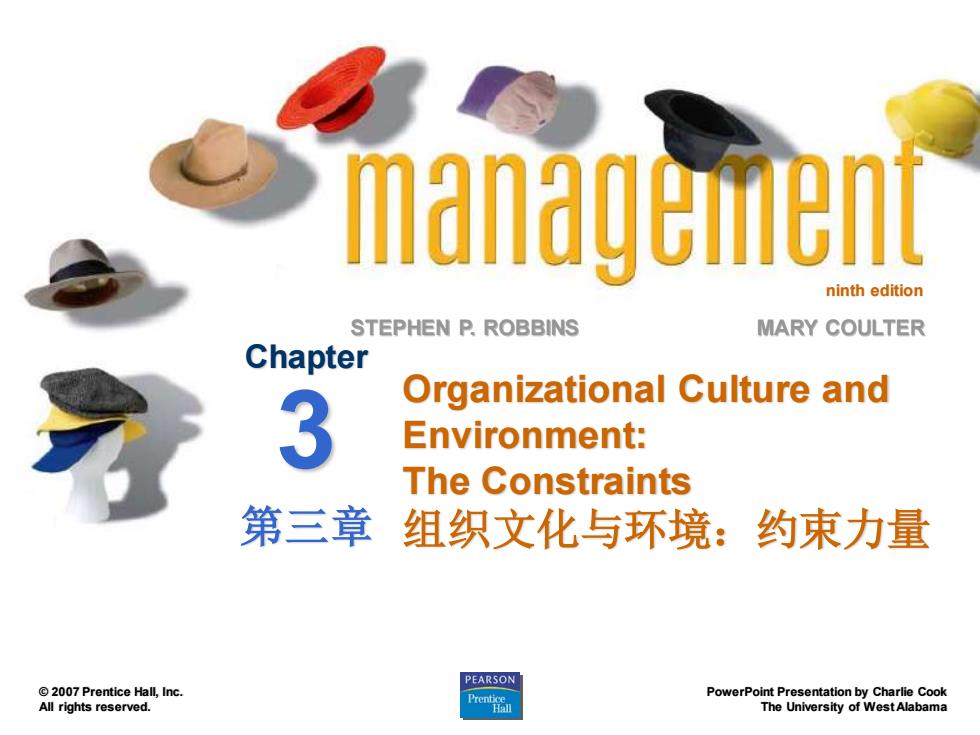
management ninth edition STEPHEN P.ROBBINS MARY COULTER Chapter Organizational Culture and 3 Environment: The Constraints 第三章 组织文化与环境: 约束力量 PEARSON 2007 Prentice Hall,Inc. PowerPoint Presentation by Charlie Cook All rights reserved. The University of WestAlabama
ninth edition STEPHEN P. ROBBINS PowerPoint Presentation by Charlie Cook The University of West Alabama MARY COULTER © 2007 Prentice Hall, Inc. All rights reserved. Organizational Culture and Environment: The Constraints 组织文化与环境:约束力量 Chapter 3 第三章
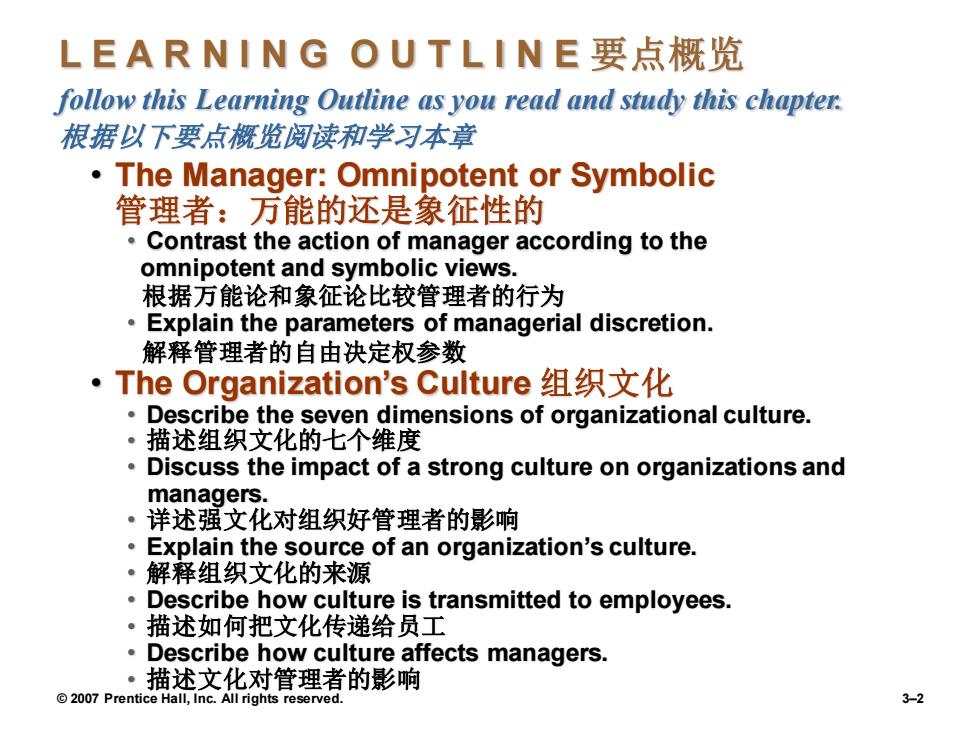
LEARNING OUTLINE要点概览 follow this Learning Outline as you read and study this chapter. 根据以下要点概览阅读和学习本章 The Manager:Omnipotent or Symbolic 管理者:万能的还是象征性的 Contrast the action of manager according to the omnipotent and symbolic views. 根据万能论和象征论比较管理者的行为 Explain the parameters of managerial discretion. 解释管理者的自由决定权参数 ·The Organization's Culture组织文化 Describe the seven dimensions of organizational culture. ·描述组织文化的七个维度 Discuss the impact of a strong culture on organizations and managers. 。 详述强文化对组织好管理者的影响 。 Explain the source of an organization's culture. 。1 解释组织文化的来源 Describe how culture is transmitted to employees. ·描述如何把文化传递给员工 Describe how culture affects managers. 描述文化对管理者的影响 2007 Prentice Hall,Inc.All rights reserved. 3-2
© 2007 Prentice Hall, Inc. All rights reserved. 3–2 L E A R N I N G O U T L I N E 要点概览 follow this Learning Outline as you read and study this chapter. 根据以下要点概览阅读和学习本章 • The Manager: Omnipotent or Symbolic 管理者:万能的还是象征性的 • Contrast the action of manager according to the omnipotent and symbolic views. 根据万能论和象征论比较管理者的行为 • Explain the parameters of managerial discretion. 解释管理者的自由决定权参数 • The Organization’s Culture 组织文化 • Describe the seven dimensions of organizational culture. • 描述组织文化的七个维度 • Discuss the impact of a strong culture on organizations and managers. • 详述强文化对组织好管理者的影响 • Explain the source of an organization’s culture. • 解释组织文化的来源 • Describe how culture is transmitted to employees. • 描述如何把文化传递给员工 • Describe how culture affects managers. • 描述文化对管理者的影响
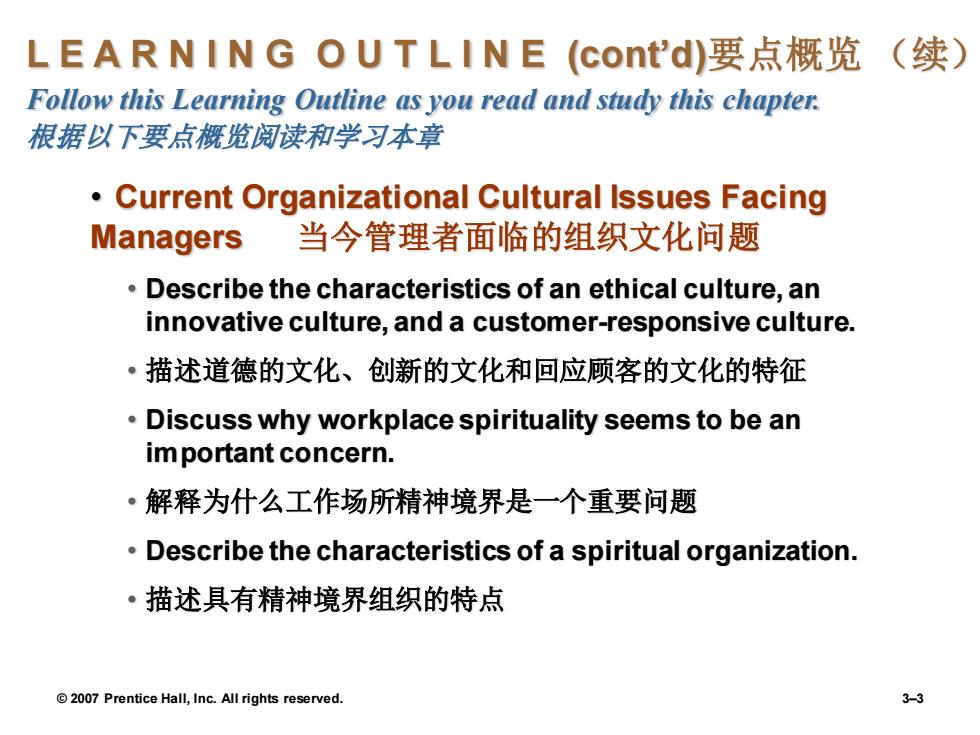
LEARNING OUTLINE(cont'd要点概览(续) Follow this Learning Outline as you read and study this chapter. 根据以下要点概览阅读和学习本章 Current Organizational Cultural Issues Facing Managers当今管理者面临的组织文化问题 Describe the characteristics of an ethical culture,an innovative culture,and a customer-responsive culture. ·描述道德的文化、创新的文化和回应顾客的文化的特征 Discuss why workplace spirituality seems to be an im portant concern. ·解释为什么工作场所精神境界是一个重要问题 Describe the characteristics of a spiritual organization. ·描述具有精神境界组织的特点 2007 Prentice Hall,Inc.All rights reserved
© 2007 Prentice Hall, Inc. All rights reserved. 3–3 L E A R N I N G O U T L I N E (cont’d)要点概览 (续) Follow this Learning Outline as you read and study this chapter. 根据以下要点概览阅读和学习本章 • Current Organizational Cultural Issues Facing Managers 当今管理者面临的组织文化问题 • Describe the characteristics of an ethical culture, an innovative culture, and a customer-responsive culture. • 描述道德的文化、创新的文化和回应顾客的文化的特征 • Discuss why workplace spirituality seems to be an important concern. • 解释为什么工作场所精神境界是一个重要问题 • Describe the characteristics of a spiritual organization. • 描述具有精神境界组织的特点
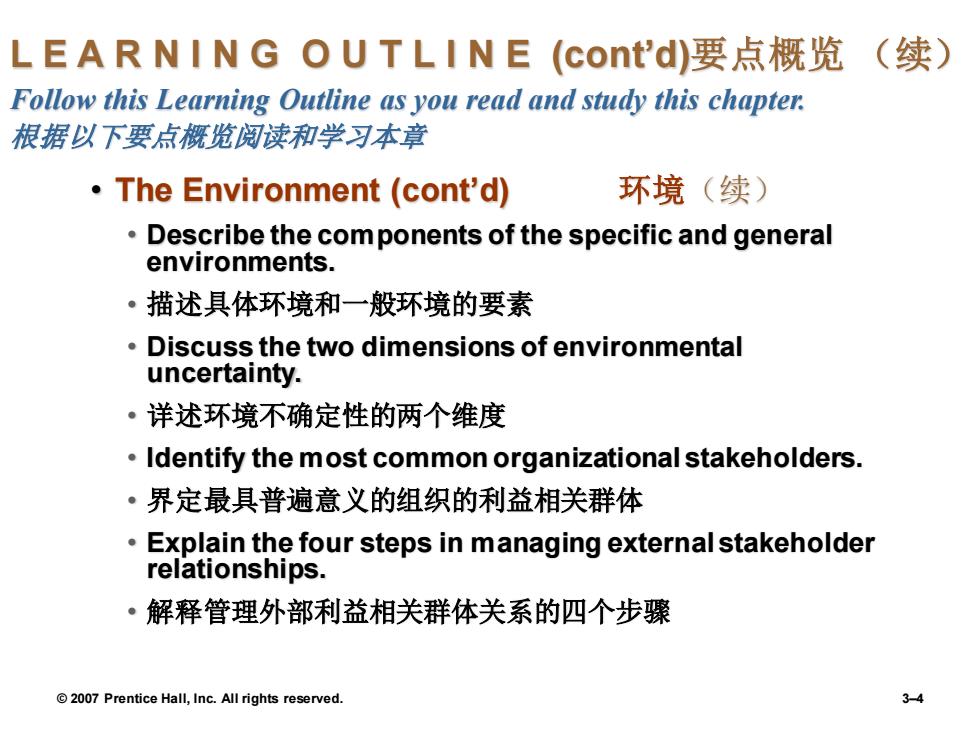
LEARNING OUTLINE(cont'd要点概览(续) Follow this Learning Outline as you read and study this chapter. 根据以下要点概览阅读和学习本章 The Environment (cont'd) 环境(续) Describe the components of the specific and general environments. ·描述具体环境和一般环境的要素 Discuss the two dimensions of environmental uncertainty. ·详述环境不确定性的两个维度 Identify the most common organizational stakeholders. ·界定最具普遍意义的组织的利益相关群体 Explain the four steps in managing external stakeholder relationships. ·解释管理外部利益相关群体关系的四个步骤 2007 Prentice Hall,Inc.All rights reserved. 3-4
© 2007 Prentice Hall, Inc. All rights reserved. 3–4 L E A R N I N G O U T L I N E (cont’d)要点概览 (续) Follow this Learning Outline as you read and study this chapter. 根据以下要点概览阅读和学习本章 • The Environment (cont’d) 环境(续) • Describe the components of the specific and general environments. • 描述具体环境和一般环境的要素 • Discuss the two dimensions of environmental uncertainty. • 详述环境不确定性的两个维度 • Identify the most common organizational stakeholders. • 界定最具普遍意义的组织的利益相关群体 • Explain the four steps in managing external stakeholder relationships. • 解释管理外部利益相关群体关系的四个步骤
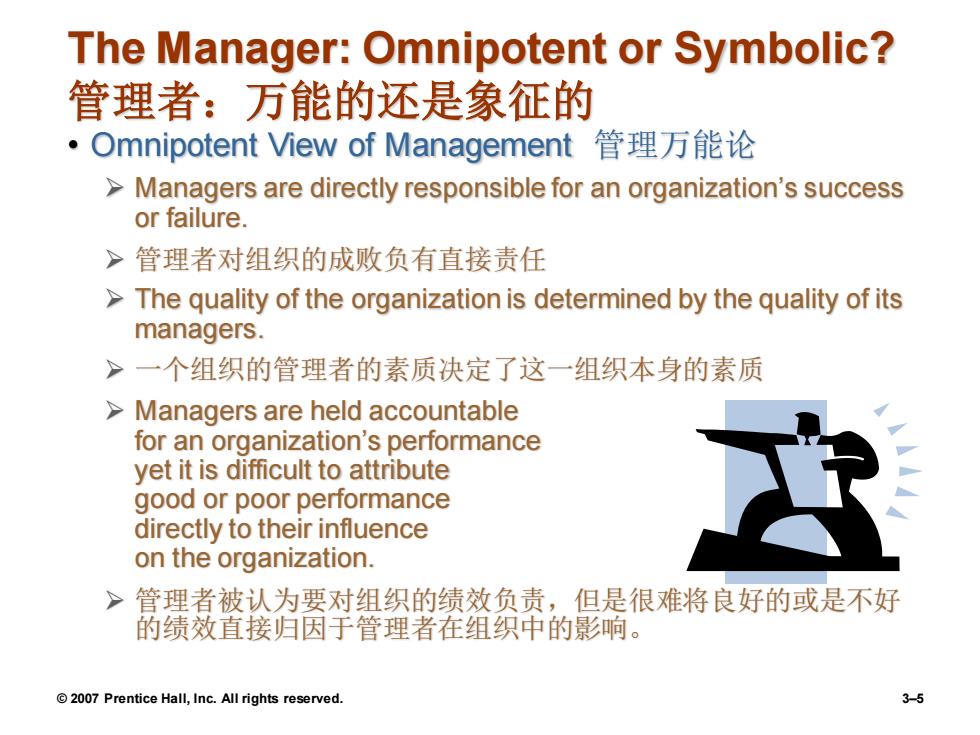
The Manager:Omnipotent or Symbolic? 管理者:万能的还是象征的 ·Omnipotent View of Management管理万能论 >Managers are directly responsible for an organization's success or failure. >管理者对组织的成败负有直接责任 >The quality of the organization is determined by the quality of its managers >一个组织的管理者的素质决定了这一组织本身的素质 >Managers are held accountable for an organization's performance yet it is difficult to attribute good or poor performance directly to their influence on the organization. 管理者被认为要对组织的绩效负责,但是很难将良好的或是不好 的绩效直接归因于管理者在组织中的影响。 2007 Prentice Hall,Inc.All rights reserved. 3-5
© 2007 Prentice Hall, Inc. All rights reserved. 3–5 The Manager: Omnipotent or Symbolic? 管理者:万能的还是象征的 • Omnipotent View of Management 管理万能论 ➢ Managers are directly responsible for an organization’s success or failure. ➢ 管理者对组织的成败负有直接责任 ➢ The quality of the organization is determined by the quality of its managers. ➢ 一个组织的管理者的素质决定了这一组织本身的素质 ➢ Managers are held accountable for an organization’s performance yet it is difficult to attribute good or poor performance directly to their influence on the organization. ➢ 管理者被认为要对组织的绩效负责,但是很难将良好的或是不好 的绩效直接归因于管理者在组织中的影响